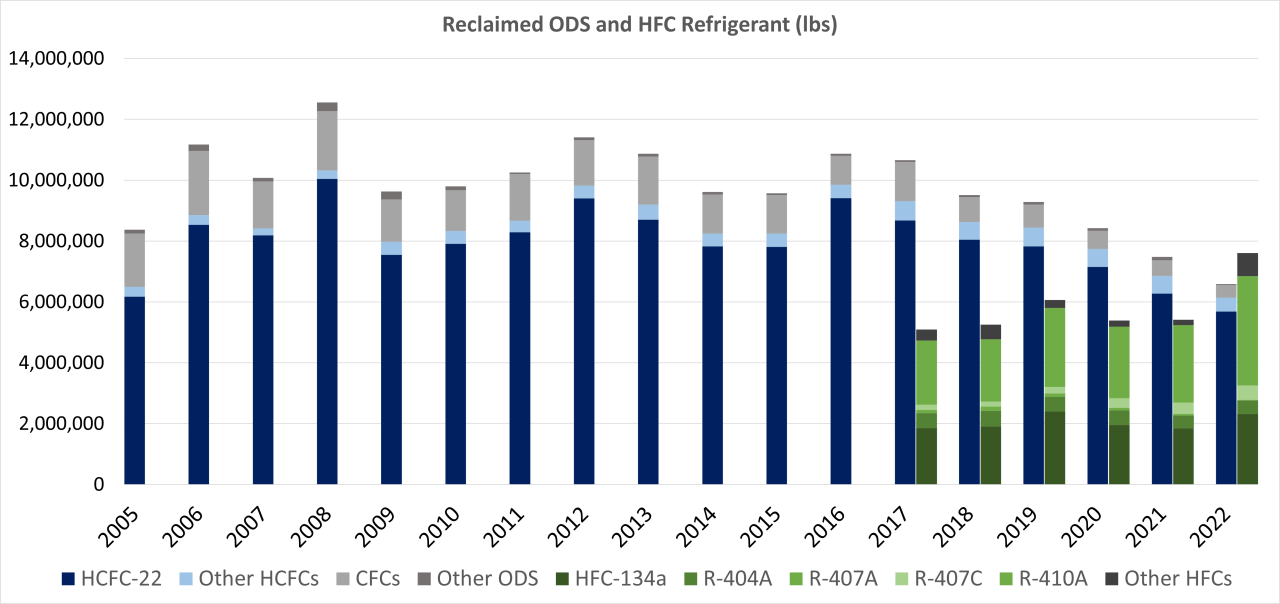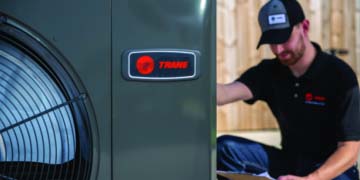Carrier collaborated with the Chemours Company to create a new refrigerant called Puron Advance, which is also known as R-454B. The goal of developing this refrigerant was to meet the targets set by the UN Montreal Protocol Kigali Amendment established in 2016.
The amendment aims to reduce the production and usage of hydrofluorocarbons (HFCs). The goal is to reduce HFCs by more than 80% over the next 30 years.
HFCs are commonly used as refrigerants, and they pose a threat to the ozone layer. R-410A, also known as Puron, replaced R-22 in the late 1080s and is currently used in many systems. However, it is a potent greenhouse gas.
In 2018, R-454B was developed as an alternative refrigerant and has now been introduced into the market.
Is Your Current System Using R-410A Refrigerant?
If your current air conditioning system uses R-410A refrigerant, you don’t need to worry about it right now. However, if you are planning to purchase a new system in 2024, you will notice a change. The use of R-410A is being phased out from all systems. These units will not be manufactured or imported after January 1st, 2025. This will lead to scarcity and a price increase. This means that if you have a system that used R-410A, refrigerant repairs will become more expensive.
The new refrigerant, R-454B, has been developed as an alternative. It is non-toxic and mildly flammable and is considered a lower global warming potential (GWP) refrigerant. Several manufacturers, including Mitsubishi Electric, Carrier, Johnson Controls, and Trane, have already chosen R-454B. Carrier started offering Puron Advance in 2023 in its ducted light commercial and residential solutions. This new refrigerant is expected to surpass the requirements of anticipated future regulations.
Carrier is committed to providing efficient and responsible solutions to its customers while also being environmentally conscious. As such, it carefully studied all alternatives and chose Puron Advance, the most viable refrigerant with the lowest environmental impact for this product category. According to Matthew Pine, President of Residential HVAC at Carrier, “The move to Puron Advance refrigerant is the next logical step in the evolution of our industry.”
Challenges for Transitioning to R-454B
Some manufacturers may choose not to switch to R-454B even though they are required to comply with the UN Montreal Protocol Kigali Amendment.
The refrigerant transition is confusing many HVAC contractors who are not yet prepared for the change. They have questions regarding the compatibility of existing gauges and whether a different refrigerant would work better or worse than R-454A.
Additionally, the refrigerant transition is happening on a state-by-state basis, which means that timing and requirements may not be consistent depending on the contractor’s location, leading to more complexity and confusion. For example, California’s mandate may differ from Ohio’s.
Honeywell has developed R-466A, which is currently in the “advance stages” of commercialization and is being tested as another potential refrigerant. The non-flammable classification of R-466A was described as a “breakthrough” when Honeywell first announced it in 2018 as Solstice N41.
Preparing for the Switch to R-454B
The training program for the transition to R-454B will cover various aspects of the fluid, such as discharge temperatures, pressure ratios, and other differences between R-454B and R-410. Our company has a state-of-the-art training center, where we conduct the training program.
We will ensure that all our technicians are well-versed in the training requirements and answer any queries they may have. Apart from our training program, ACCA (Air Conditioning Contractors of America) and NATE (North American Technician Excellence) plan to offer certification programs.

Source: EPA.gov
R-454B Safety
Homeowners may have concerns about the safety and handling standards of the new refrigerant, R-454B. However, there is no need to worry as our technicians have undergone comprehensive training to handle the refrigerant safely. R-454B is made up of two mildly flammable refrigerants, but our technicians are well-equipped to handle it safely.
What is Driving the Changes in Refrigerants?
According to the International Energy Agency, the energy required for air conditioning is expected to triple by the year 2050. This means that ten new air conditioning units are likely to be sold every second over the next 30 years.
However, this growing demand has environmental implications. The current refrigerants used in HVAC systems have been accused of contributing to the increase in greenhouse gas emissions.
As climate change continues to be a critical issue, companies need to develop sustainable, eco-friendly products and practices. It will become a federal regulation to do so.
In December 2020, President Trump signed the American Innovation and Manufacturing (AIM) Act of 2020 into law, which mandates the Environmental Protection Agency (EPA) to reduce the production and consumption of HFCs by 85% over the next 15 years.
How Will This Affect You?
Currently, there is no immediate impact that you will experience. If your air conditioning or heat pump system is functioning well, there is no need to take any action. However, it is important to keep in mind that if your current system uses R-410A refrigerant, then it is advisable to have a plan in place for a new air conditioning system. Since this refrigerant will soon be phased out, its shortage will cause an increase in repair costs. Your HVAC contractor may also not have adequate supplies of it.
In some cases, contractors may be ready to add more R-410A to your system, but this would only be a temporary solution as it implies that there is a leak somewhere in your system that needs to be fixed. While the leak can be repaired, this point marks the beginning of the decline of your system and it may start costing more than it’s worth, especially when compared to purchasing a new and energy-efficient system that doesn’t use R-410A.
How Refrigerants Work in Your Air Conditioning System
The liquid refrigerant present in the air conditioning system passes through the coils and changes to gas during the cooling process.
Depending on its state, it either absorbs or releases heat. The refrigerant travels from the indoor to the outdoor unit, and as the pressure changes, it captures heat and eliminates it before cycling back. The furnace blower and ductwork then circulate the cooled air throughout your home.
Proper equipment is required to maintain the correct pressures for different refrigerants to function efficiently during various stages of the process.
How Do You Dispose of an R-410A Refrigerant?
Releasing R-410A into the atmosphere is not recommended and should be avoided. However, it is a common occurrence. To dispose of R-410A appropriately, it is best to consult an HVAC technician who has been certified by the EPA. They have the necessary equipment to collect the refrigerant in sealed canisters, which can then be transported to processing centers that specialize in safe disposal methods.

Source: Chemours.com
Is My System Using R-410A?
On rare occasions, you may find the refrigerant type listed on the HVAC unit. In other instances, you may need to search for the brand and model online to find out. If you’re unable to locate this information, reach out to your HVAC installer for assistance in identifying the refrigerant type.
Is R-454B Refrigerant the Best to Use?
R-410A is the widely used refrigerant that is considered to be more eco-friendly than R-22. While some experimental refrigerants are being tested, R-410A is the most common refrigerant used in modern units. R-454B is quickly becoming the industry standard.
What if My System Uses R-22 Refrigerant?
The use of R-22 refrigerant has been prohibited by the federal government in the United States, both for manufacturing and import, but it should still be available for the duration of your HVAC system’s lifetime. However, it may not be the most cost-effective option when compared to other alternatives.
Is it necessary to replace your R22 HVAC system? No, not necessarily. Depending on the age and condition of your air conditioner, it may still have several years of life left before any issues arise.
However, this may change if your system develops a leak or if a part needs to be replaced. The cost of repairing older systems can often be high enough to warrant considering a replacement. If an R-22 system’s refrigerant and/or parts are significantly more expensive to repair, then replacement may be the best choice.
If you are considering replacing your HVAC system soon, you may need to purchase one that used R-410A, or even one using R-454B. There should be enough R410-A to last the lifetime of your system, but the cost of repairs and refrigerant may increase over time.
Ready for your next HVAC project?
Our licensed and insured technicians are ready to help with any residential or commercial HVAC need you may have. Contact us to get a quote.










